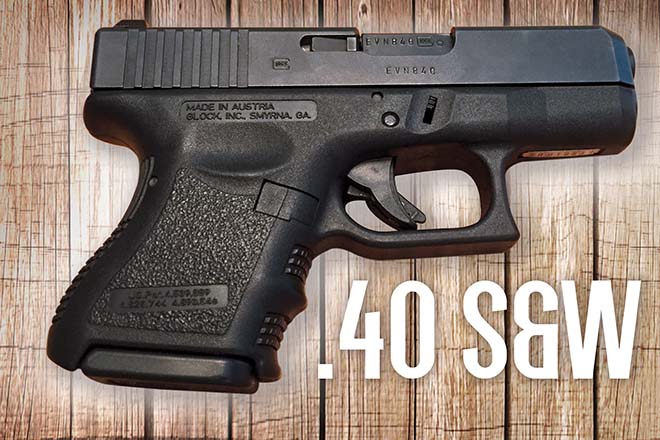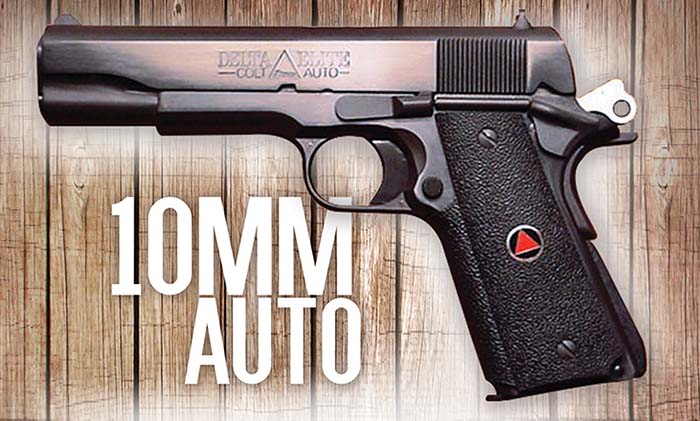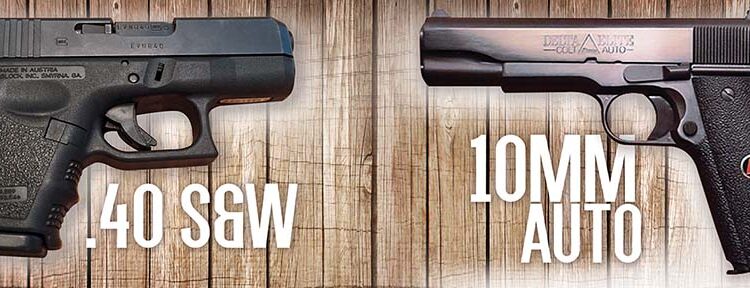By Paul Evancoe
There is an old saying that is worth consideration: “Never get into a gunfight with a caliber that does not start with anything less than a 4.”
There are a number of arguments about which particular round is better, the 10mm Auto or the .40 Smith and Wesson. The performance argument between the 9mm Parabellum and .45 ACP rounds, for example, seems to never end, but few have heard the same argument applied to the 10mm Auto and .40 Smith and Wesson cartridges. There are some who swear by the 10mm Auto round, but most gun enthusiasts have never shot one much less considered an analytical comparison between the 10mm Auto and the .40 S&W. Why are these two particular rounds comparable?
Let’s start with the basics: 10mm is the metric equivalent for .40 caliber, or 10 millimeters equals .40 of an inch. Therefore, both bullets are the same diameter. So now you might think, what is the difference? The answer lies in cartridge case length, not in bullet diameter. The 10mm Auto has a cartridge casing length of 25mm, while the .40 S&W has a case length of 22mm. Both cartridges are rimless and possess the same base dimensions. Both employ a large pistol primer as their ignition source. Both perform best with the same 1 in 16-inches, 6-groove rifling twist rate. That is right – except for their case length (a slim 3 millimeters difference) they are comparatively identical. Let’s walk through this conundrum and see if we can make sense out of it.

Many believe, and some gun writers have published, an erroneous history of the two rounds. It goes like this. After a fatal 1986 Miami shootout between FBI agents and heavily armed robbers, the FBI blamed the deaths of two of their agents, and the wounding of five other agents, on the ineffectiveness of their underpowered 9mm and .38 Special handguns. The FBI’s solution was to identify and rearm their Special Agents with a more lethal round. So in conjunction with the gun industry, the FBI adopted the 10mm Auto round because of its knockdown power. As logical as that might sound, it is far from true.
Famed shooter Jeff Cooper, largely developed the 10mm round in the very early 1980s, well before the FBI’s 1986 fatal shootout. Cooper, in the late 1970s, began experimenting (wildcatting) with the concept of a larger caliber semi-automatic pistol round (not a revolver round) that would have more effective knockdown power than a .45 ACP. Cooper’s purpose was personal defense, Cooper’s claim to fame, in a military combat pistol application. Remember, in 1979 the U.S. military was actively seeking a more lethal replacement for its aging M1911A1 .45 ACP pistol inventory with a new high- capacity combat pistol. Several years later, Beretta ultimately won this competition with their 9mm NATO compatible Model 92S pistol.
Cooper developed his 10mm Auto round based on superior ballistic performance over the .45 ACP. The 10mm Auto round was smaller in diameter than the .45 ACP round, so more rounds could be stuffed in the same length magazine as compared to the .45 ACP. The 10mm Auto round itself flew faster, further and carried with it significantly more energy upon impact than the .45 ACP round. Initial technical testing showed promise, so Cooper chose to mate his new 10mm Auto round with the Bren-Ten semi-automatic pistol, a close operating relative to the CZ-75.

This served several purposes as a potential military pistol replacement contender. The Bren-Ten had comparable ergonomics and functions to the M1911A1 (reducing the training requirement), and it could carry more rounds in its magazine because it’s cartridge was 10mm (.40) vs. .45 diameter. Additionally, the 10mm Auto round was comparatively more lethal than the .45 ACP round, and all this was encompassed within DoD’s new pistol requirement. Cooper was confident he had a winner by marrying his new 10mm Auto round to the Bren-Ten pistol.
With a less-arched ballistic path (upon firing) relative to other handgun cartridges, the 10mm Auto is acknowledged as a high velocity “flat-shooting” round. In a full potential comparison, the 10mm Auto delivers slightly higher energy than an average .357 Magnum load and below standard .41 Magnum rounds. More powerful loadings can equal or exceed the performance of the .357 Magnum, and retain more kinetic energy at 100 yards than the .45 ACP has at the muzzle. The performance of the 9mm Luger round does not even come close. This all made Cooper’s new cartridge a solution looking for a problem.
How did the FBI get hooked up with Cooper? Cooper ran an excellent shooting school that taught Cooper’s unique style of carry, draw, and shoot techniques. The FBI had been sending their Special Agents to Cooper’s shooting school for years, as did the U.S. Special Operations Forces. Cooper’s combat shooting techniques were, and still are, tried, tested, and proven as well as unquestionably credible, so a trusted relationship between Cooper and the FBI had long existed. Cooper himself was not only a shooter of renown, but he was also a businessman extraordinaire, and he leveraged his longstanding trusted relationship with the FBI to market his 10mm Auto round and the pistol he had chosen to fire it. The FBI had a problem and Cooper offered an immediate solution. The FBI did not question their trusted friend’s advice.

So what happened? Initially produced overseas by ammunition manufacturer FFV Norma AB of Åmotfors, Sweden, the 10mm Bren-Ten semi-automatic pistol was expensive to manufacture. The gun’s design and questionable substandard manufacturing quality control led to operational reliability issues when the pistol was exposed to off range real-world operational environments: lint, grit, dry, and wet. Moreover, Cooper’s 10mm Auto round was not NATO interoperable, a bottom line requirement for military acceptance. However, there was a saving grace – the FBI and Hollywood.
Following the FBI’s previously mentioned tragic 1986 Miami shootout, they briefly adopted Cooper’s 10mm Auto for FBI-wide use, an expensive decision. In fact, in early 1990 they contracted Heckler & Koch to produce a limited quantity of the MP5 sub-machineguns utilizing the 10mm Auto cartridge. These specially built MP-5s were designated the MP5/10 and were provided specifically to the FBI’s Hostage Rescue Team, another expensive decision. Ironically, during that brief FBI embracement during the late 1980s, Hollywood picked up on the 10mm’s uniqueness. Casting it as a favorite gun/round in the Miami Vice TV series, surging its public notoriety and shooters’ popularity (if a Hollywood character uses it on-screen it must be good).
Even with the momentum of popularity, the FBI discontinued use of the 10mm Auto within a couple of years because the round’s recoil was determined to be excessively strong, and the preponderance of their agents disliked it. One might conclude that those FBI agents who fired it at Cooper’s school might have made that determination years earlier, but if such a determination was made it was swept under the carpet in the FBI’s rush to find a lethality solution. An additional detractor for the FBI was the high cost and low availability (in quantity) of 10mm Auto ammunition for training. The FBI quickly realized it needed a high-performance pistol round with less recoil that was cheaper and available, but they were now stuck with the 10mm Auto.
Sadly, it all came to an abrupt finale and somewhat happy ending in the early 1990s with the advent of the .40 S&W, but we must digress a bit to explain the historical dynamics in play at the time.
As early as 1988, the FBI was testing various 10mm Auto reduced loads in an attempt to decrease its objectionable recoil. The FBI had no question that the 10mm Auto’s full-power commercial load out-performed all other semi-automatic pistol cartridges of the era. This fact made it singularly ideal for law enforcement use, but its undesirable recoil needed mitigation. A solution was necessary that wouldn’t jeopardize the professional careers of those involved in the FBI’s very expensive decision to replace their pistol and ammunition inventory with the 10mm Auto.
The FBI experimented with hand-loaded reduced propellant ammunition until they found the proper recoil reducing load that didn’t significantly sacrifice the 10mm Auto’s ballistic performance, and a specification for reduced-recoil ammunition was created. It seemed to be an 80% solution. The FBI awarded a production contract to the Federal Cartridge Corporation and the “10mm Lite”, or “10mm FBI” load, was born. This load remains in production by various ammunition manufacturers today.
There was, however, an inherent problem using this lighter load not identified because the FBI did only technical testing under ideal range conditions and no operational testing (there is a huge purposeful difference between the two).
The lighter load resulted in pistol feed and ejection problems. Because of its reduction in the pistol slide backstroke (blowback) force required to reliably eject spent cartages, and chamber fresh rounds on the slide’s forward stroke. Failures were especially evident when the pistol was fired in an up or down vertical position as one might when be engaging an opponent on a roof or down a stairwell.
The problem with downloading (reducing the propellant quantity) in any cartridge is the airspace that results inside the cartridge case. If you visualize a cartridge that is fully loaded with propellant, there is little to no air space between the top of the powder column and the base of the bullet, with the bullet installed at its specified depth in the cartridge case. This is the optimal physical scenario for full propellant combustion and its subsequent development of the maximum pressure necessary to optimally propel the bullet down range.
Bullet velocity is a product of the velocity of propellant combustion (burn speed). Therefore, bullet velocity cannot exceed its propellant pressure velocity. Consequently, a downloaded cartridge that possesses an airspace allowing the powder column to relax horizontally will not “burn” with the same consistency that a compact powder column (no airspace) burns. Airspace leads to radical propellant burn pressures and inherent inaccuracy because of pressure fluctuations. So, how do you fix that problem? The answer is to reduce the cartridge case length and eliminate the air space.
At this point myth again carries the story. Many believe the FBI went to Smith and Wesson and Winchester, and they jointly developed the smaller case length cartridge resulting in .40 Smith and Wesson. The facts show otherwise. It may also be appropriate to point out that Industry develops stuff. The FBI does not develop hardware or anything else, save investigative reports.
Smith and Wesson is a very competitive gun manufacturer and market share is a big deal. Unlike the government, they are a for-profit business. Seeing the 1986 popularity of the 10mm Auto, Colt unexpectedly decided to chamber their Colt Government model 1911 in 10mm Auto and name it the Delta Elite pistol. Colt debuted their Delta Elite model in 1987. Following prolonged media attention and screen accounts aggrandizing the Army’s elite Delta Force notoriety following the failed 1980 Operation Eagle Claw attempt to rescue 52 American diplomats being held hostage by Islamic militants in Tehran. Smith and Wesson, an avid Colt competitor, decided they wanted a share of the 10mm Auto market.
S&W design engineers understood the issues surrounding the full-up 10mm Auto and the reduced recoil 10mm FBI load. Their business solution was to create a new cartridge unique to Smith and Wesson that would provide identical performance of the 10mm FBI load, but for marketing be unique to Smith and Wesson. They needed something they could own. This was a business decision based upon a very smart market analysis, not an FBI-driven requirement.
is a very competitive gun manufacturer and market share is a big deal. Unlike the government, they are a for-profit business.
The FBI immediately got on board with Smith and Wesson who shared their accomplishment of fathering the new round with them (an FBI face-saving marketing strategy). With the FBI now touting the .40 S&W’s virtues to the law enforcement community, along with their claim of co-development, the rest of the shooting world wanted a gun chambered in Smith and Wesson’s new .40 S&W. All the major gun manufacturers scrambled to rechamber their 9mm pistols in this new cartridge which instantly proliferated its popularity even further. Momentum was established, and the course was set. It was only a matter of time until the 10mm Auto fell from grace and its obscurity followed.
S&W engineers shortened the 10mm Auto’s case from 25mm to 22mm without sacrificing the performance parameters of the 10mm FBI load. However, why not shorten it to 21mm or even 20mm? The reason was that the 22mm length case allowed for it to widely function in pistols with smaller frame dimensions designed for the 9mm Luger round. The 9mm Luger round was popular among shooters with smaller hands and those who craved less recoil. Smith and Wesson named it the .40 S&W departing entirely from the 10mm metric brand. Thereby established a new high-performance all-American round that most existing pistols chambered in 9mm could handle with an easy barrel and magazine change out. Offering a teaming relationship, they got Winchester to manufacture the new ammunition offering a range of bullet weights. Smith and Wesson’s marketing was brilliant.
Today, the popular .40 S&W rounds are cheap, abundantly available, and come in a wide range of bullet weights and styles. Although most shooters would consider 165 or 180 grain standard for range or self-defense use bullets, the round is available as light as 135 grains to as heavy as 200 grains. In terms of muzzle velocity, you will find the speediest .40 S&W rounds zip downrange at about 1,200 feet per second. Larger rounds pack a serious punch with some 180-grain rounds that carry a muzzle velocity close to 1,100 feet per second and deliver more than 450 foot-pounds of energy on target. Incidentally, because of the wide range of bullet weights, styles and velocities, the .40 S&W round is ideal for use with sound suppressor equipped pistols with no performance tradeoff. Try one; you will like it.
The 10mm Auto is still around. Reportedly, the FBI’s Hostage Rescue Team still has it in their armory, as do some U.S. military special mission units, but its civilian popularity has remained stalled. As recently as 2015, Sig Saur offered a version of their P-220 workhorse chambered in 10mm Auto with relatively dismal sales numbers. It seems those shooters who have guns chambered in 10mm Auto like them more for the nostalgia than their performance. The .40 S&W dominates the law enforcement and self-defense market (as well as casual plinkers) who want the performance of a .40 without the obnoxious recoil of a 10mm Auto. Finally, for the shooter who intends to win in a gunfight, the .40 S&W is a 90% solution between affordability, availability, and superb lethality.
| This article first appeared in Small Arms Review V21N1 (January 2017) |












